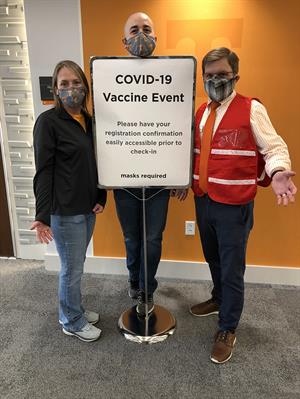The New Engagement: COVID Testing, Vaccinating at Student Unions
From the living room of the campus to the university COVID-19 testing and vaccination site, student unions are being recognized as ideal virus testing and vaccination sites for the same reasons they are historically central to a thriving campus community. Physical location, skilled staff, facility infrastructure, a collaborative mindset, and a comforting ambience each have played into student unions becoming ideal locations for vaccinating not only campus populations, but also members of the surrounding community.
For many union professionals who have already had to perfect occupancy scaling, classroom conversions, food court reinventions, and, of course, virtual parallels to about everything they have offered on site in the past, becoming a COVID testing or vaccination site is just another spin of the wheel.
“For me, it is so very positive, and it gives me even more hope,” said Jill Zambito, assistant vice chancellor for student life at the University of Tennessee–Knoxville, as part of a team that prepared the student union as a vaccination site in early February. “Navigating yet another new endeavor during the pandemic provides even more humor and challenges, and our planning team is thrilled to have the chance to host these events.”
Tennessee student union assistant director Alison Ward agreed: “Hosting this kind of event shows that we are fully supportive of the campus community, and to be honest, what the staff of the union can make happen when a unique challenge presents itself.”
The events underscore how student union operations are quintessentially collaborative environments that excel at producing a continuum of successful hybrid events.
At Tennessee, the process involved health officials from the state, county, and campus, the campus pharmacy, the college of nursing, the campus emergency operations center, and the student union. “Having so many folks from different corners of campus come together from something so monumental brings joy and hope,” Ward added.
Both Ward and Zambito, along with other union staff, received their first vaccinations, as did students over 75, those working as campus surveillance testing or isolation/quarantine workers, and students studying, working, or training in nursing, speech and audiology, psychology, psychiatry, and clinical social work.
Both the Stony Brook University student activities center and student union have been transformed into COVID-19 reaction sites. Testing started at the student activities center in October and the union first became a vaccination site early this year.
“Who’d have thought setting up stanchions would be an area of expertise in the middle of a pandemic,” said Stony Brook director of student centers Howard Gunston. “Last year we were thinking we wouldn’t be using our pipe and drape, and now we’re using everything.”
Like Tennessee, Stony Brook’s student center spaces have seen transition after transition, from reduced occupancy and limited services, to becoming socially distanced classroom spaces, and then transforming into COVID testing and vaccination sites. The Stony Brook union hosted a two-day, first vaccination distribution that saw 1,000 people vaccinated in 12 hours. People had to preregister, they came in one way and left another, and they had to wait on site for 20 minutes after receiving the vaccination to ensure they didn’t incur any adverse reactions.
“We used the whole building, and from a facilities perspective, we were happy to scramble and pull things together,” Gunston said. “There were those of us who at the time were more hesitant, but we’ve become increasingly comfortable. It’s been a moment of pride knowing we’re helping the community and very rewarding seeing our expertise help during a pandemic like this. For us, now it just happens to be the event happening in that room.”

For testing, Stony Brook students, faculty, and staff swipe a QR code on the smartphone to register their profile when they arrive, and if they don’t have a smartphone there are computers on site with disposable keyboard covers. The entire process is contactless, with visitors picking up a swab kit, walk to a technician who shows them the test method, they then swab, seal, and drop in a collection bin. The whole process takes just a few minutes.
At Northern Illinois University, Holmes Student Center Executive Director Jennifer Manning admitted that some staff were initially nervous when testing started there in December. Learning that as many as 600 people would be coming through student center doors each day for testing made that a legitimate concern, but those being tested—all students living on campus are tested every two weeks—must register in advance and visitors enter and exit through designated doors. Testing time in the building is down to just five minutes, Manning said.
“We still have students coming here to work and study. The library just across the street has reduced the space for student access, so we’re actually seeing more students coming here,” she said. “Our bookstore is open, dining is carry-out only, but our student organizations are still meeting virtually.”
As medical staff conducting the testing began booting up laptops, coupled with students accessing their reservations on smartphones, student center staff realized the biggest issue was wi-fi capability. With no wi-fi access points in the ballroom being used for testing, Holmes Student Center found itself getting an unexpected and appreciated tech upgrade.
Student unions have long been recognized as a reflection of a campus ecology defined by human characteristics, organizational structure, college constructs, and the physical environment. The union mission is critical to that of the institution, and as testing and vaccinating for COVID-19 has found a home within these facilities, it looks to have created a new opportunity for the narrative of engagement and community to play-out once again.
“We’re used to seeing our centers full of hybrid, unique activities, so COVID testing has been kind of cool because we’re seeing the doors opening and closing again,” Gunston said. “Sure we had to throw all our known diagrams for line control and staging out the window, but we expect to be here doing testing through the spring.”
The Centers for Disease Control has recognizing an ongoing need for new satellite or temporary testing and vaccination sites, so it has released a guidance that provides resources for new clinics to be established by public and private organizations. The resource includes a best practices checklist, a supplement to that checklist called the “Ten Principles for Holding a Safe Vaccination Clinic,” a frequently asked questions section, and even a vaccination clinic pledge for organizations that upon signing recognizes them at the National Adult and Immunization Summit website.
Becoming a testing site did not necessitate changing any of the services the student center at the University of Wisconsin–Whitewater was already providing, like grab-and-go food service and reduced capacity meeting rooms. But Angela Meldonian, the student center’s executive director, recognized that the broader restrictions that have resulted from COVID-19, like limited dining and social seating, room capacity restrictions, and reduced activities, continued to take a toll.
“More students are starting to take advantage of the center’s services, but last fall we didn’t have a lot of traffic because students were afraid to leave their rooms,” she said. “Typically, our building is the place to gather, socialize, and relax, and that defined the overall student experience. We continue to battle how to provide a safe and welcoming environment and providing students with what they are looking for and what they need.”
Of particular concern were first-year students who traditionally would be seeing older students using the building in a myriad of ways. “They are not seeing that right now, so we’re working extra hard to reach out to that group to make sure they understand what we can do and what we can provide,” Meldonian said.
The center has increased its social media footprint, generated more video content, and upped the efforts of its marketing and graphics departments.
“We’re trying to change the framework from ‘This is what you can’t do,’ to ‘This is what you can do,’” Meldonian said.

